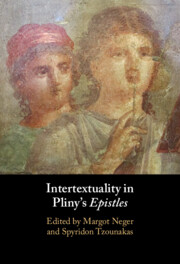Book contents
- Intertextuality in Pliny’s Epistles
- Intertextuality in Pliny’s Epistles
- Copyright page
- Contents
- Contributors
- Acknowledgements
- Abbreviations
- Introduction
- Part I Intertextuality and Interdiscursivity in Pliny’s Letters
- Part II Models and Anti-Models: Pliny’s Interaction with Oratory and Natural History
- Part III Pliny and Seneca: Discourses of Grief and Posthumous Reputation
- Chapter 7 Pliny’s Seneca and the Intertextuality of Grief
- Chapter 8 Intertextuality and Posthumous Reputation in Pliny’s Letter on the Death of Silius Italicus (Plin. Ep. 3.7)
- Part IV Pliny’s Villas and Their Poetic Models
- Part V Pliny Turns Nasty: Satire and the Scoptic Tradition
- Part VI Final Thoughts: Discourses of Representation and Reproduction
- Bibliography
- General Subject Index
- Index Locorum
Chapter 7 - Pliny’s Seneca and the Intertextuality of Grief
from Part III - Pliny and Seneca: Discourses of Grief and Posthumous Reputation
Published online by Cambridge University Press: 07 September 2023
- Intertextuality in Pliny’s Epistles
- Intertextuality in Pliny’s Epistles
- Copyright page
- Contents
- Contributors
- Acknowledgements
- Abbreviations
- Introduction
- Part I Intertextuality and Interdiscursivity in Pliny’s Letters
- Part II Models and Anti-Models: Pliny’s Interaction with Oratory and Natural History
- Part III Pliny and Seneca: Discourses of Grief and Posthumous Reputation
- Chapter 7 Pliny’s Seneca and the Intertextuality of Grief
- Chapter 8 Intertextuality and Posthumous Reputation in Pliny’s Letter on the Death of Silius Italicus (Plin. Ep. 3.7)
- Part IV Pliny’s Villas and Their Poetic Models
- Part V Pliny Turns Nasty: Satire and the Scoptic Tradition
- Part VI Final Thoughts: Discourses of Representation and Reproduction
- Bibliography
- General Subject Index
- Index Locorum
Summary
This chapter analyses how Pliny absorbs the consolatory philosophy of Seneca. It focuses on his intertextual use of two of Seneca’s epistles (98 and 99) that treat death, arguing that Ep. 98 looms behind Corellius Rufus’ decision to die (1.12), and that Regulus’ display of grief following the death of his son (4.2) echoes Seneca’s condemnation of improper mourning practice in Ep. 99. The allusions reveal Pliny’s opportunistic engagement with Seneca’s philosophical consideration of grief, agreeing and disagreeing with his epistolary predecessor depending upon the specific circumstances of the bereavement. Both his absorption and rejection of Seneca’s arguments show that he could engage and apply philosophical concepts to express his own grief or criticise other’s.
Keywords
- Type
- Chapter
- Information
- Intertextuality in Pliny's Epistles , pp. 149 - 163Publisher: Cambridge University PressPrint publication year: 2023

